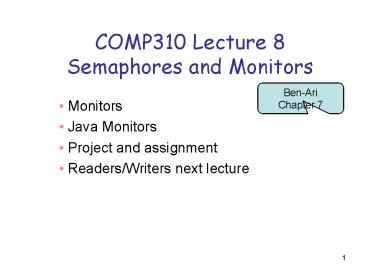COMP310 Lecture 8 Semaphores and Monitors - PowerPoint PPT Presentation
1 / 27
Title:
COMP310 Lecture 8 Semaphores and Monitors
Description:
signalC() might not have an effect. 9. Condition Variables and ... waiting to enter may obtain exclusive access. synchronized method1()? synchronized method2 ... – PowerPoint PPT presentation
Number of Views:99
Avg rating:3.0/5.0
Title: COMP310 Lecture 8 Semaphores and Monitors
1
COMP310 Lecture 8Semaphores and Monitors
Ben-Ari Chapter 7
- Monitors
- Java Monitors
- Project and assignment
- Readers/Writers next lecture
2
Monitors
- A high level synchronisation mechanism, related
to objects in OO languages. - Hoare, 1974.
- Used to encapsulate synchronisation logic.
3
Monitors
- A monitor has some
- private variables, like an object
- public operations (a lot like methods)?
- these guarantee exclusive access
- condition variables
- Allow processes to block and wait, or to signal.
Somewhat like semaphores.
4
Monitors
Can't be accessed outside monitor code
monitor RWint x 0, y 0 cond c1, c2
op anOp ... op anotherOp... op
thirdOp... op fourthOp...
Condition Variables
Only one process ever executing an operation
5
Monitors
E1 E2 E3
Op1
p has exclusive access
Op2
cond c1 W1,W2
cond c2 W3,W4
E1,E2,E3 are processes waiting to enter (i.e,
obtain exclusive access)?
6
Processes and Monitors
E1 E2 E3
Op1
p finishes its operation
Op2
cond c1 W1,W2
cond c2 W3,W4
There are no guarantees about which of
E1,E2,E3 can now enter the monitor. (Starvation
possible here.)?
7
Condition Variables
- A condition variable has an associated wait queue
and two operations. - waitC(cv)
- process enqueues itself and blocks
- when it becomes blocked, it releases exclusive
access - signalC(cv)?
- unblocks a waiting proc. if there is one
- has no effect if queue is empty
8
Condition Variables and Blocking Semaphores
- A process doesn't necessarily block when calling
wait() on a semaphore - waitC() always causes the process to block
- signal() always has an effect on the semaphore
- signalC() might not have an effect
9
Condition Variables and Blocking Semaphores
- For weak semaphores, signal() unblocks an
arbitrary process - signalC() always unblocks the process at the head
of the queue - For semaphores, a process unblocked by
signal()can begin execution immediately - For a condition variable, this depends on the
signalling policy.
10
Processes and Monitors
E1 E2 E3
Op1
p has exclusive access
Op2
cond c1 W1,W2
cond c2 W3,W4
11
Processes and Monitors
E1 E2 E3
Op1
p has signalled c1
Op2
cond c1 W1,W2
cond c2 W3,W4
W1,W2 are waiting in the order shown.
12
Signalling Policies
- So which processes can get exclusive access now?
- The most important policies are
- Waiting process gets exclusive access (signal and
wait). - The signalling process retains exclusive access
(signal and continue).
13
Signal and Wait (EltSltW)?
E1 E2 E3
Op1
W1 has exclusive access
Signal Q p is blocked
Op2
cond c1 W1,W2
cond c2 W3,W4
Now, p is in a queue containing signalled
processes. Runs before any other process enters.
14
Signal and Continue (EltWltS)?
E1 E2 E3
Op1
p has exclusive access
Op2
cond c1 W1,W2
cond c2 W3,W4
The signalled process can run later.
15
Evaluating Signalling Policies
- Signal-and-wait guarantees that monitor state has
not changed between signal of a condition and
resumption of woken thread - Signal-and-continue enables signalling thread to
change state - May need to recheck condition
- Doesn't normally make a difference
16
Monitors and Java
- Entering a synchronized corresponds to entering a
monitor. - All monitor operations guarantee mutual
exclusion. - In Java, you must explicitly declare synchronized
methods.
17
Monitors and Java
- Monitors are not condition variables, they
contain condition variables - In Java, all objects behave like condition
variables in that they have o.wait() and
o.notify() operations. - Condition variables prevent starvation by using a
wait queue. - In Java, threads block in a wait set, so there
are no guarantees about the order in which they
will be unblocked.
18
Monitors and Java
- Processes waiting at condition variables, can
only be unblocked one at a time. - In Java, you can call notifyAll() to unblock all
waiting threads. - Several condition variables can be contained
within one monitor. - In Java, only the object itself functions as a
condition variable for that object.
19
Java Monitors
synchronized method1()?
E1 E2 E3
synchronized method2()?
p has exclusive access
waitset W1,W2
Order not guaranteed.
20
Java Monitors
synchronized method1()?
E1 E2 E3
synchronized method2()?
p calls this.notify()?
waitset W1,W2
Order not guaranteed.
21
Java Monitors (EWltS)?
synchronized method1()?
E1 E2 E3
synchronized method2()?
p has exclusive access
waitset W1,W2
One of W1,W2 has been unblocked
22
Java Monitors (EWltS)?
synchronized method1()?
E1 E2 E3
synchronized method2()?
p finishes its sync block
waitset W1,W2
Either the unblocked process or a process waiting
to enter may obtain exclusive access.
23
Semaphores With Monitors
monitor Semint value kcond notZero op
wait if (value0)? waitC(notZero)
value--
op signal value signalC(notZero)?
24
Semaphores With Monitors
public synchronized void semWait()? throws
InterruptedException if (value
0)? this.wait() value-- public
synchronized void semSignal()? throws
InterruptedException value this.notify()
25
Semaphores With Monitors
public synchronized void semWait()? throws
InterruptedException while (value
0)? this.wait() value--
26
Project One
- Allocating Arbitrary Resources
- Files
- Forks
- Communication channels etc
- Processes request sets of named resources
- Deadlock will occur if resources acquired in bad
orders. - Need to analyse acquisition orders, and implement
two of them in Java
27
Project One
- Implement a test/driver program
- 30 mark for implementation
- Good, clean well commented code
- 70 for report
- Analysis of acquisition techniques
- Design and documentation of your program
- Design of experiments that explore behaviour and
performance of strategies - Analysis of experimental results































